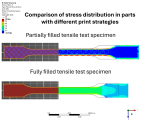3D printing of components using the fused filament fabrication (FFF) process is based on melting and depositing individual filament strands along a predefined print path. Changing the process parameters (temperature, printing speed, etc.) has a major impact on the bond strength between the deposited filament strands and thus on the resulting component properties. In addition, the sequential deposition of the strands creates locally very different process conditions, resulting in anisotropic material behavior.
In previous methods of computer-aided simulation (FEM), isotropic material behavior is generally assumed, meaning that the material deforms uniformly in all spatial directions under load. Anisotropic behavior, such as that found in fiber-reinforced components, can also be modeled in FEM under the assumption of uniform anisotropy throughout the entire component. However, the anisotropy generated in the FFF process differs fundamentally from previous considerations. Based on the pressure path used, there will be locally very different material properties.
This project aims to investigate solutions for implementing pressure path-induced anisotropy in FEM simulations, taking into account the key process-related influencing factors. The goal is to correctly predict component behavior when a defined process sequence is specified. Based on this, printing strategies are to be derived that best meet the boundary conditions required by the user and predict potential weak points in the component.








